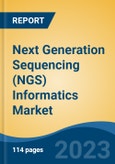Speak directly to the analyst to clarify any post sales queries you may have.
10% Free customizationThis report comes with 10% free customization, enabling you to add data that meets your specific business needs.
Key Market Drivers
Rising Adoption of Precision Medicine and Genomic-Based Diagnostics
The widespread integration of precision medicine and genomic diagnostics into clinical workflows is a key driver of the NGS informatics market. By enabling the analysis of entire genetic profiles, NGS facilitates identification of disease-causing mutations and supports individualized treatment strategies. Government-led initiatives such as the NIH’s “All of Us Research Program” reflect this trend, collecting genetic data from over one million participants - over 600,000 of whom had enrolled by 2023.This surge in data fuels the demand for informatics platforms that can store, process, and interpret high-throughput sequencing information. Additionally, broader insurance coverage for genomic testing in countries like the United States is encouraging greater adoption of NGS technologies in hospitals and clinical labs. According to CMS, spending on NGS-based tests has significantly increased, underlining the growing clinical importance of these tools. As a result, demand for scalable NGS informatics systems that can automate variant analysis and support clinical decisions using AI and ML is accelerating across healthcare systems.
Key Market Trends
Integration of Artificial Intelligence and Machine Learning in NGS Informatics
The integration of AI and ML into NGS informatics is revolutionizing genomic data analysis by enabling rapid, accurate, and efficient interpretation of complex datasets. These technologies are embedded into pipelines for variant calling, annotation, and clinical reporting, helping to identify structural rearrangements and polygenic risk scores. Tools like DeepVariant and AlphaFold have improved the interpretation of genomic data in oncology and rare disease diagnostics. Government backing, such as the U.S. National Artificial Intelligence Initiative and the EU’s Horizon Europe program, underscores global efforts to integrate AI in biomedical research. AI models also enhance the utility of genomic data when integrated with electronic health records, enabling personalized, evidence-based treatment recommendations. As these models become increasingly sophisticated and validated, they are expected to become central to commercial NGS informatics solutions, supporting the broader implementation of precision medicine.Key Market Players
- Abbott Laboratories
- F. Hoffmann-La Roche Ltd.
- PerkinElmer, Inc.
- SOPHiA GENETICS SA
- Precigen, Inc.
- QIAGEN N.V.
- Illumina, Inc.
- Agilent Technologies, Inc.
- Eagle Genomics Limited
- BGI Genomics Co., Ltd.
Report Scope:
In this report, the Global Next Generation Sequencing (NGS) Informatics Market has been segmented into the following categories, in addition to the industry trends which have also been detailed below:Next Generation Sequencing (NGS) Informatics Market, By Product & Services:
- Storage and Computing Tools
- Commercial Data Analysis
- Data Interpretation and Reporting Tools
- Next Generation Sequencing (NGS) Informatics Services
- Laboratory Information Management Systems (LIMS)
Next Generation Sequencing (NGS) Informatics Market, By Application:
- Drug Discovery
- Genetic Screening
- Disease Diagnosis
- Others
Next Generation Sequencing (NGS) Informatics Market, By End User:
- Hospitals and Diagnostic Centers
- Pharmaceutical and Biotechnology Companies
- Academic and Research Institutions
Next Generation Sequencing (NGS) Informatics Market, By Region:
- North America
- United States
- Mexico
- Canada
- Europe
- France
- Germany
- United Kingdom
- Italy
- Spain
- Asia-Pacific
- China
- India
- South Korea
- Japan
- Australia
- South America
- Brazil
- Argentina
- Colombia
- Middle East and Africa
- South Africa
- Saudi Arabia
- UAE
Competitive Landscape
Company Profiles: Detailed analysis of the major companies present in the Global Next Generation Sequencing (NGS) Informatics Market.Available Customizations:
With the given market data, the publisher offers customizations according to a company's specific needs. The following customization options are available for the report.Company Information
- Detailed analysis and profiling of additional market players (up to five).
This product will be delivered within 1-3 business days.
Table of Contents
Companies Mentioned
- Abbott Laboratories
- F. Hoffmann-La Roche Ltd.
- PerkinElmer, Inc.
- SOPHiA GENETICS SA
- Precigen, Inc.
- QIAGEN N.V.
- Illumina, Inc.
- Agilent Technologies, Inc.
- Eagle Genomics Limited
- BGI Genomics Co., Ltd.
Table Information
| Report Attribute | Details |
|---|---|
| No. of Pages | 185 |
| Published | May 2025 |
| Forecast Period | 2024 - 2030 |
| Estimated Market Value ( USD | $ 5.48 Billion |
| Forecasted Market Value ( USD | $ 18.74 Billion |
| Compound Annual Growth Rate | 22.7% |
| Regions Covered | Global |
| No. of Companies Mentioned | 10 |









